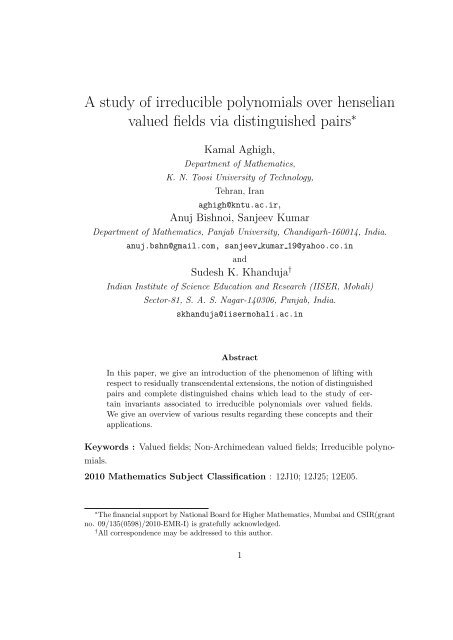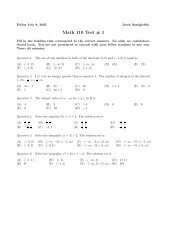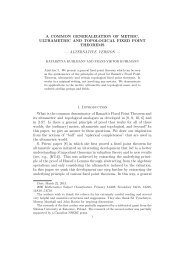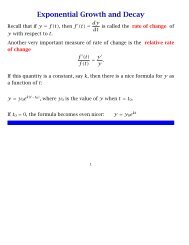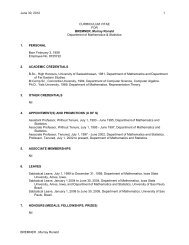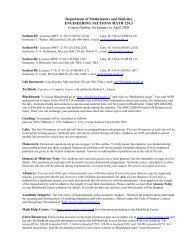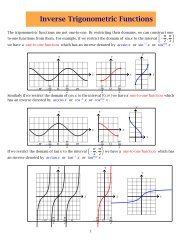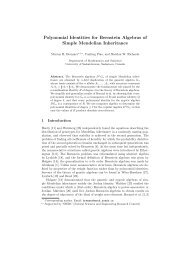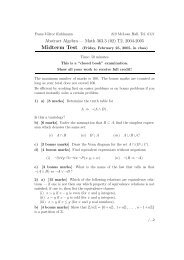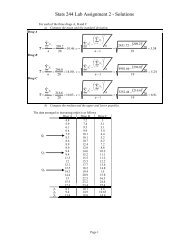A study of irreducible polynomials over henselian valued fields via ...
A study of irreducible polynomials over henselian valued fields via ...
A study of irreducible polynomials over henselian valued fields via ...
Create successful ePaper yourself
Turn your PDF publications into a flip-book with our unique Google optimized e-Paper software.
A <strong>study</strong> <strong>of</strong> <strong>irreducible</strong> <strong>polynomials</strong> <strong>over</strong> <strong>henselian</strong><br />
<strong>valued</strong> <strong>fields</strong> <strong>via</strong> distinguished pairs ∗<br />
Kamal Aghigh,<br />
Department <strong>of</strong> Mathematics,<br />
K. N. Toosi University <strong>of</strong> Technology,<br />
Tehran, Iran<br />
aghigh@kntu.ac.ir,<br />
Anuj Bishnoi, Sanjeev Kumar<br />
Department <strong>of</strong> Mathematics, Panjab University, Chandigarh-160014, India.<br />
anuj.bshn@gmail.com, sanjeev kumar 19@yahoo.co.in<br />
and<br />
Sudesh K. Khanduja †<br />
Indian Institute <strong>of</strong> Science Education and Research (IISER, Mohali)<br />
Sector-81, S. A. S. Nagar-140306, Punjab, India.<br />
skhanduja@iisermohali.ac.in<br />
Abstract<br />
In this paper, we give an introduction <strong>of</strong> the phenomenon <strong>of</strong> lifting with<br />
respect to residually transcendental extensions, the notion <strong>of</strong> distinguished<br />
pairs and complete distinguished chains which lead to the <strong>study</strong> <strong>of</strong> certain<br />
invariants associated to <strong>irreducible</strong> <strong>polynomials</strong> <strong>over</strong> <strong>valued</strong> <strong>fields</strong>.<br />
We give an <strong>over</strong>view <strong>of</strong> various results regarding these concepts and their<br />
applications.<br />
Keywords : Valued <strong>fields</strong>; Non-Archimedean <strong>valued</strong> <strong>fields</strong>; Irreducible polyno-<br />
mials.<br />
2010 Mathematics Subject Classification : 12J10; 12J25; 12E05.<br />
∗ The financial support by National Board for Higher Mathematics, Mumbai and CSIR(grant<br />
no. 09/135(0598)/2010-EMR-I) is gratefully acknowledged.<br />
† All correspondence may be addressed to this author.<br />
1
It is an old and interesting problem to <strong>study</strong> the properties <strong>of</strong> a given <strong>irreducible</strong><br />
polynomial with coefficients in a <strong>valued</strong> field (K, v). Some <strong>of</strong> the important tools<br />
<strong>of</strong> valuation theory which are used extensively in <strong>study</strong>ing such problems are the<br />
notion <strong>of</strong> lifting <strong>of</strong> <strong>polynomials</strong> and distinguished pairs. We first briefly recall<br />
these concepts along with a survey <strong>of</strong> results obtained in this direction and state<br />
some results regarding the connection between the two concepts.<br />
In what follows, v is a <strong>henselian</strong> Krull valuation <strong>of</strong> arbitrary rank <strong>of</strong> a field K<br />
with valuation ring Rv, maximal ideal Mv, residue field K = Rv/Mv and ˜v is its<br />
unique prolongation to a fixed algebraic closure K <strong>of</strong> K having value group G. For<br />
an element ξ belonging to the valuation ring <strong>of</strong> ˜v, ξ will denote its ˜v-residue, i.e.,<br />
the image <strong>of</strong> ξ under the canonical homomorphism from the valuation ring R˜v <strong>of</strong><br />
˜v onto its residue field and for a polynomial f(x) ∈ R˜v[x], ¯ f(x) will stand for the<br />
polynomial <strong>over</strong> the residue field <strong>of</strong> ˜v obtained by replacing each coefficient <strong>of</strong><br />
f(x) by its ˜v-residue. For any subfield L <strong>of</strong> K, L, G(L) will denote respectively<br />
the residue field and the value group <strong>of</strong> the valuation <strong>of</strong> L which is the restriction<br />
<strong>of</strong> ˜v to L. Any <strong>irreducible</strong> polynomial x n + an−1x n−1 + · · · + a0 belonging to K[x]<br />
can be lifted in the usual way to yield <strong>irreducible</strong> <strong>polynomials</strong> <strong>over</strong> Rv <strong>of</strong> degree<br />
n. In 1995, Popescu and Zaharescu [24] extended the notion <strong>of</strong> usual lifting by<br />
introducing lifting with respect to a residually transcendental extension. Recall<br />
that a prolongation w <strong>of</strong> v to a simple transcendental extension K(x) <strong>of</strong> K<br />
is called residually transcendental if the residue field <strong>of</strong> w is a transcendental<br />
extension <strong>of</strong> the residue field <strong>of</strong> v. In 1983, Ohm [22] proved the well known<br />
Ruled Residue Theorem conjectured by Nagata [21], which says that the residue<br />
field <strong>of</strong> a residually transcendental prolongation w <strong>of</strong> v to K(x) is a simple<br />
transcendental extension <strong>of</strong> a finite extension <strong>of</strong> the residue field <strong>of</strong> v. Popescu<br />
et al. in a series <strong>of</strong> papers that followed, characterized residually transcendental<br />
extensions through minimal pairs defined below (cf. [3, 4]).<br />
Definition. Let (K, v), ( K, ˜v) be as above and G be the value group <strong>of</strong> ˜v. A<br />
pair (α, δ) ∈ K × G will be called a minimal pair (more precisely, a (K, v)-<br />
minimal pair) if whenever β belongs to K with [K(β) : K] < [K(α) : K], then<br />
˜v(α − β) < δ.<br />
For a (K, v)- minimal pair (α, δ), we shall denote by wα,δ the valuation <strong>of</strong><br />
2
K(x) defined by<br />
wα,δ<br />
<br />
i<br />
ci(x − α) i<br />
<br />
= min {˜v(ci) + iδ}, ci ∈<br />
i K;<br />
its restriction to K(x) will be denoted by wα,δ. It is known that a prolongation<br />
w <strong>of</strong> v to K(x) is residually transcendental if and only if w = wα,δ for some<br />
(K, v)-minimal pair (α, δ) (cf. [3, Theorem 2.1]). It is also known that for two<br />
(K, v)-minimal pairs (α, δ), (α1, δ1) wα,δ = wα1,δ1 if and only if δ = δ1 and<br />
˜v(α1 − α ′ ) ≥ δ for some K-conjugate α ′ <strong>of</strong> α (see [4], [20, Theorem 2.1]). So<br />
the valuation wα,δ is determined by the minimal polynomial f(x) (say) <strong>of</strong> α<br />
<strong>over</strong> K and δ. A simple description <strong>of</strong> wα,δ and its residue field is given by the<br />
result stated below proved in [3] using f(x)-expansion 1 <strong>of</strong> any given polynomial<br />
g(x) ∈ K[x].<br />
Theorem 1. Let (K, v), ( K, ˜v) be as above and (α, δ) be a (K, v)-minimal pair.<br />
Let f(x) be the minimal polynomial <strong>of</strong> α <strong>over</strong> K <strong>of</strong> degree m and let λ stand for<br />
wα,δ(f(x)). Then the following hold:<br />
(i) For any polynomial g(x) belonging to K[x] with f(x)-expansion <br />
gi(x)f(x) i ,<br />
deg gi(x) < m, one has wα,δ(g(x)) = min<br />
i {˜v(gi(α)) + iλ}.<br />
(ii) Let e be the smallest positive integer such that eλ ∈ G(K(α)) and h(x)<br />
belonging to K[x] be a polynomial <strong>of</strong> degree less than m with ˜v(h(α)) = eλ,<br />
e f(x)<br />
<br />
then the wα,δ-residue <strong>of</strong><br />
h(x)<br />
f(x)e<br />
is transcendental <strong>over</strong> K(α) and<br />
h(x)<br />
e f(x)<br />
<br />
the residue field <strong>of</strong> wα,δ is canonically isomorphic to K(α) .<br />
h(x)<br />
The description <strong>of</strong> the residue field <strong>of</strong> wα,δ given in Theorem 1 led Popescu<br />
and Zaharescu [24] to generalize the notion <strong>of</strong> usual lifting. In this attempt, they<br />
introduced the concept <strong>of</strong> lifting <strong>of</strong> a polynomial belonging to K(α)[Y ] (Y an<br />
indeterminate) with respect to a (K, v)-minimal pair (α, δ) as follows:<br />
Definition. For a (K, v)-minimal pair (α, δ), let f(x), m, λ, e and h(x) be as in<br />
Theorem 1. A monic polynomial F (x) belonging to K[x] is said to be a lifting <strong>of</strong><br />
1The expansion <strong>of</strong> a polynomial g(x) ∈ K[x] obtained on dividing it by successive powers <strong>of</strong><br />
f(x) <strong>of</strong> the type <br />
gi(x)f(x) i , gi(x) ∈ K[x], deg gi(x) < deg f(x), is called the f(x)-expansion<br />
<strong>of</strong> g(x).<br />
i<br />
3<br />
i
a monic polynomial T (Y ) belonging to K(α)[Y ] having degree t ≥ 1 with respect<br />
to (α, δ) if the following three conditions are satisfied:<br />
(i) deg F (x) = etm,<br />
(ii) wα,δ(F (x)) = wα,δ(h(x) t ) = etλ,<br />
F (x)<br />
e f(x)<br />
<br />
(iii) the wα,δ-residue <strong>of</strong> is T .<br />
h(x) t h(x)<br />
To be more precise, the above lifting will be referred to as the one with respect to<br />
(α, δ) and h(x). This notion <strong>of</strong> lifting extends the usual one because a usual lifting<br />
x n + an−1x n−1 + · · · + a0 <strong>of</strong> a polynomial x n + an−1x n−1 + · · · + a0 ∈ K[x] is lifting<br />
with respect to the minimal pair (0,0). In 1997, Khanduja and Saha proved<br />
that a polynomial belonging to K[x], which is a lifting <strong>of</strong> a monic <strong>irreducible</strong><br />
polynomial T (Y ) = Y belonging to K(α)[Y ] with respect to a (K, v)-minimal<br />
pair (α, δ), is <strong>irreducible</strong> <strong>over</strong> K (see [18, Theorem 2.2]). As a consequence <strong>of</strong> this<br />
result, they also extended Schönemann Irreducibility Criterion [25, Chapter 3,<br />
D] and Eisenstein Irreducibility Criterion for <strong>polynomials</strong> <strong>over</strong> arbitrary <strong>valued</strong><br />
<strong>fields</strong>; infact <strong>polynomials</strong> satisfying the hypothesis <strong>of</strong> these criteria were shown<br />
to be liftings <strong>of</strong> linear <strong>polynomials</strong> with respect to some suitable (K, v)-minimal<br />
pairs (cf. [18]).<br />
Clearly there are many liftings <strong>of</strong> a given polynomial with respect to a minimal<br />
pair (α, δ). This leads to the following natural question:<br />
Let (K, v) be a <strong>henselian</strong> <strong>valued</strong> field <strong>of</strong> any rank and (α, δ) be a<br />
(K, v)-minimal pair. Let F (x) and F1(x) be two liftings <strong>of</strong> a monic<br />
<strong>irreducible</strong> polynomial T (Y ) = Y belonging to K(α)[Y ] with respect<br />
to (α, δ). Then given any root θ <strong>of</strong> F (x), does there exist a root η <strong>of</strong><br />
F1(x) such that K(θ) = K(η)?<br />
In 2002, Bhatia and Khanduja [5] showed that the answer to the above ques-<br />
tion is ‘no’ in general and proved that it is ‘yes’ if each finite extension <strong>of</strong> (K, v)<br />
is tamely ramified 2 Indeed they proved the following result in this direction.<br />
2 As in [15], a finite extension (K ′ , v ′ ) <strong>of</strong> a <strong>henselian</strong> <strong>valued</strong> field (K, v) is said to be defectless<br />
if [K ′ : K] = ef, where e, f are the index <strong>of</strong> ramification and the residual degree <strong>of</strong> the extension<br />
v ′ /v. A defectless extension (K ′ , v ′ )/(K, v) is said to be tamely ramified if the residue field <strong>of</strong><br />
v ′ is a separable extension <strong>of</strong> the residue field <strong>of</strong> v and the index <strong>of</strong> ramification <strong>of</strong> v ′ /v is not<br />
divisible by the characteristic <strong>of</strong> the residue field <strong>of</strong> v.<br />
4
Theorem 2. Let (K, v) be a <strong>henselian</strong> <strong>valued</strong> field <strong>of</strong> any rank and (α, δ) be a<br />
(K, v)-minimal pair. Let F (x) and F1(x) be two liftings <strong>of</strong> a monic <strong>irreducible</strong><br />
polynomial T (Y ) = Y belonging to K(α)[Y ] with respect to (α, δ). Suppose that<br />
ξ is a root <strong>of</strong> F (x) and η is a root <strong>of</strong> F1(x). Then G(K(ξ)) = G(K(η)) and K(ξ)<br />
is K-isomorphic to K(η).<br />
Theorem 3. Let (K, v) be as in the above theorem. Assume that each finite<br />
extension <strong>of</strong> (K, v) is tamely ramified and (α, δ) be a (K, v)-minimal pair. Let<br />
F (x) and F1(x) be two liftings <strong>of</strong> a monic <strong>irreducible</strong> polynomial T (Y ) = Y<br />
belonging to K(α)[Y ] with respect to (α, δ) and h(x). Then for any root ξ <strong>of</strong><br />
F (x), there exists a root η <strong>of</strong> F1(x) such that K(ξ) = K(η).<br />
It is immediate from the definition <strong>of</strong> a minimal pair that for any α in K<br />
and δ in G, (α, δ) is a (K, v)-minimal pair; however as can be easily seen a pair<br />
(α, δ) belonging to ( K\K) × G is a (K, v)-minimal pair if and only if δ is strictly<br />
greater than each element <strong>of</strong> the set M(α, K) defined by<br />
M(α, K) = {˜v(α − β) | β ∈ K, [K(β) : K] < [K(α) : K]}.<br />
In 2000, Khanduja, Popescu and Roggenkamp proved that M(α, K) has an upper<br />
bound in G if and only if [K(α) : K] = [ K(α) : K], where ( K, ˆv) is completion<br />
<strong>of</strong> (K, v) (see [20, Theorem 3.1]). This gave rise to the invariant δK(α) defined<br />
to be the supremum <strong>of</strong> the set M(α, K) (for the sake <strong>of</strong> definition <strong>of</strong> supremum,<br />
G may be viewed as a subset <strong>of</strong> its Dedekind order completion). The invariant<br />
δK(α) is called the main invariant associated to α. In 2002, it was proved that<br />
the set M(α, K) has a maximum element for every α in K \ K if and only if<br />
each simple algebraic extension <strong>of</strong> (K, v) is defectless (see [1]). Since any finite<br />
extension <strong>of</strong> a complete discrete rank one <strong>valued</strong> field (K, v) is defectless, it<br />
follows that M(α, K) has a maximum element for all α in K \ K in case <strong>of</strong> such<br />
a <strong>valued</strong> field (K, v). This led Popescu and Zaharescu [24] to define the notion <strong>of</strong><br />
distinguished pairs for these <strong>valued</strong> <strong>fields</strong>, which was later extended to arbitrary<br />
<strong>henselian</strong> <strong>valued</strong> <strong>fields</strong> as follows:<br />
Definition. Let (K, v) be <strong>henselian</strong> <strong>valued</strong> field <strong>of</strong> arbitrary rank. A pair (θ, α)<br />
<strong>of</strong> elements <strong>of</strong> K with [K(θ) : K] > [K(α) : K] is said to be a (K, v)-distinguished<br />
pair if α is an element <strong>of</strong> smallest degree <strong>over</strong> K for which ˜v(θ − α) = δK(θ).<br />
5
Distinguished pair gives rise to distinguished chains in a natural manner. A<br />
chain θ = θ0, θ1, . . . , θr <strong>of</strong> elements <strong>of</strong> K will be called a complete distinguished<br />
chain for θ if (θi, θi+1) is a distinguished pair for 0 i r − 1 and θr ∈ K. It<br />
is immediate from what has been said above that in case (K, v) is a complete<br />
discrete rank one <strong>valued</strong> field, then each θ in K \ K has a complete distinguished<br />
chain. In 2005, Aghigh and Khanduja [2] characterized those elements θ ∈ K \K<br />
for which there exists a complete distinguished chain when (K, v) is a <strong>henselian</strong><br />
<strong>valued</strong> field <strong>of</strong> arbitrary rank. Indeed they proved the following theorem.<br />
Theorem 4. Let (K, v) and ( K, ˜v) be as in the above theorem. An element<br />
θ ∈ K \ K has a complete distinguished chain with respect to (K, v) if and only<br />
if K(θ) is a defectless extension <strong>of</strong> (K, v).<br />
It is also known that complete distinguished chains for an element θ in K \ K<br />
give rise to several invariants associated with θ which satisfy some fundamental<br />
relations as is clear from Theorems 5-7 stated below. These invariants happen<br />
to be the same for all K-conjugates <strong>of</strong> θ and hence are invariants <strong>of</strong> the minimal<br />
polynomial <strong>of</strong> θ <strong>over</strong> K.<br />
Theorem 5. Let (K, v) and ( K, ˜v) be as in the foregoing theorem. Let (θ, α)<br />
and (θ, β) be two (K, v)- distinguished pairs and f(x), g(x) be the minimal poly-<br />
nomials <strong>of</strong> α, β <strong>over</strong> K, respectively. Then G(K(α)) = G(K(β)), K(α) = K(β)<br />
and ˜v(f(θ)) = ˜v(g(θ)).<br />
Theorem 6. Let (K, v) and ( K, ˜v) be as in the above theorem. If θ = θ0, θ1, . . . , θr<br />
and θ = η0, η1, . . . , ηs are two complete distinguished chains for θ ∈ K \ K, then<br />
r = s and [K(θi) : K] = [K(ηi) : K] for 1 ≤ i ≤ s.<br />
Theorem 7. With (K, v) and ( K, ˜v) as above, let θ = θ0, θ1, . . . , θr and θ =<br />
η0, η1, . . . , ηs are two complete distinguished chains for an element θ ∈ K \ K. If<br />
fi(x) and gi(x) denote respectively the minimal <strong>polynomials</strong> <strong>of</strong> θi and ηi <strong>over</strong> K,<br />
then the following hold for 1 ≤ i ≤ s:<br />
(i) G(K(θi)) = G(K(ηi));<br />
(ii) K(θi) = K(ηi);<br />
(iii) ˜v(θi−1 − θi) = ˜v(ηi−1 − ηi);<br />
(iv) ˜v(fi(θi−1)) = ˜v(gi(ηi−1)).<br />
6
It is clear form Theorems 6 and 7 that if θ = θ0, θ1, . . . , θs is a complete<br />
distinguished chain for an element θ <strong>of</strong> K \ K, then the number s, called the<br />
length <strong>of</strong> the chain for θ, the chain <strong>of</strong> groups G(K(θ0)) ⊇ G(K(θ1)) ⊇ · · · ⊇<br />
G(K(θs)) = G(K) and the tower <strong>of</strong> <strong>fields</strong> K(θ0) ⊇ K(θ1) ⊇ · · · ⊇ K(θs) = K,<br />
together with the finite sequence ˜v(θ − θ1) > ˜v(θ1 − θ2) > · · · > ˜v(θs−1 − θs)<br />
are invariants <strong>of</strong> θ. If fi(x) stands for the minimal polynomial <strong>of</strong> θi <strong>over</strong> K and<br />
λi for ˜v(fi(θi−1)), then it follows from Theorem 1.8(iv) that λ1, λ2, . . . , λs are<br />
also independent <strong>of</strong> the chain for θ. It may be pointed out that Ota [23] gave a<br />
method to determine these invariants when K is a finite extension <strong>of</strong> the field <strong>of</strong><br />
p-adic numbers and [K(θ) : K] is not divisible by p. This method was extended<br />
in 2005 by Khanduja and Singh [19] to <strong>valued</strong> <strong>fields</strong> (K, v) <strong>of</strong> arbitrary rank.<br />
Indeed the following theorem was proved in this regard [19, Theorem 1.2].<br />
Theorem 8. Let (K, v) be a <strong>henselian</strong> <strong>valued</strong> field and ( K, ˜v) be as before. Sup-<br />
pose that K(θ) is a finite tame extension <strong>of</strong> (K, v) <strong>of</strong> degree more than one and<br />
that c1 > c2 > · · · > cr are all the distinct members <strong>of</strong> the set {˜v(θ − θ ′ ) | θ ′ =<br />
θ runs <strong>over</strong> K-conjugates <strong>of</strong> θ}. Then<br />
(a) any complete distinguished chain for θ with respect to (K, v) has length r;<br />
(b) given a complete distinguished chain θ = θ0, θ1, . . . , θr for θ, the following<br />
hold for 1 ≤ i ≤ r :<br />
(i) δK(θi−1) = ˜v(θi−1 − θi) = ci,<br />
(ii) K(θi) ⊆ K(θi−1),<br />
(iii) [K(θ) : K(θi)] = t1 + t2 + · · · + ti + 1, where ti is the number <strong>of</strong> elements<br />
in the set {θ ′ | θ ′ runs <strong>over</strong> K-conjugates <strong>of</strong> θ with ˜v(θ − θ ′ ) = ci}.<br />
Further the <strong>fields</strong> K(θi) are uniquely determined by θ.<br />
Liftings and distinguished pairs are related to each other by the following<br />
theorem which was partially proved in [5, Proposition 2.3] and now refined in<br />
the following form in [17, Proposition 2.6].<br />
Theorem 9. Let (K, v) be a <strong>henselian</strong> <strong>valued</strong> field <strong>of</strong> arbitrary rank and (α, δ)<br />
be a (K, v)-minimal pair. Let f(x) be the minimal polynomial <strong>of</strong> α <strong>over</strong> K <strong>of</strong><br />
degree m and λ, e, h(x) be as in Theorem 1. Let g(x) ∈ K[x] be a lifting <strong>of</strong> a<br />
monic polynomial T (Y ) not divisible by Y <strong>of</strong> degree t belonging to K(α)[Y ] with<br />
respect to (α, δ). Then the following hold:<br />
7
(i) ˜v(θ − α) ≤ δ for each root θ <strong>of</strong> g(x).<br />
(ii) Given any root θ <strong>of</strong> g(x), there exists a K-conjugate θ ′ <strong>of</strong> θ such that<br />
˜v(θ ′ − α) = δ and ˜v(f(θ ′ )) = ˜v(f(θ)) = λ.<br />
<br />
f(θi)<br />
(iii) If θi is a root <strong>of</strong> g(x) with ˜v(θi − α) = δ, then the ˜v- residue <strong>of</strong><br />
e <br />
is<br />
h(α)<br />
a root <strong>of</strong> T (Y ).<br />
Using liftings <strong>of</strong> <strong>polynomials</strong>, a refinement <strong>of</strong> the classical Hensel’s Lemma<br />
stated below as Theorem 10 has been proved for complete rank-1 <strong>valued</strong> <strong>fields</strong><br />
(see [16, Theorem 1.1]); it can be easily seen that its statement is same as that<br />
<strong>of</strong> Hensel’s Lemma when the minimal pair (α, δ) is (0, 0) and h = 1. However<br />
it is an open problem whether Theorem 10 holds for <strong>henselian</strong> <strong>valued</strong> <strong>fields</strong> <strong>of</strong><br />
arbitrary rank or not.<br />
Theorem 10. Let (K, v) be a complete rank-1 <strong>valued</strong> field with value group Gv<br />
and ( K, ˜v), (α, δ), wα,δ, f(x), m, λ and e be as in Theorem 1. Assume that eλ<br />
belongs to Gv with eλ = v(h) for some h in K. Let Z denote the wα,δ-residue<br />
<strong>of</strong> f(x)e<br />
and F (x) belonging to K[x] be such that wα,δ(F (x)) = 0. If the wα,δ-<br />
h<br />
residue <strong>of</strong> F (x) is the product <strong>of</strong> two coprime <strong>polynomials</strong> T (Z), U(Z) belonging<br />
to K(α)[Z] with T (Z) monic <strong>of</strong> degree t ≥ 1, then there exist G(x), H(x) ∈ K[x]<br />
such that F (x) = G(x)H(x), deg G(x) = etm and the wα,δ-residue <strong>of</strong> G(x), H(x)<br />
are T (Z), U(Z) respectively.<br />
Liftings have also been used to establish the irreduciblity <strong>of</strong> Eisenstein-Dumas<br />
<strong>polynomials</strong> defined below. Recall that a polynomial g(x) = anx n + an−1x n−1 +<br />
· · · + ao be a polynomial with coefficients in Z is said to be an Eisenstein-Dumas<br />
polynomial with respect to a prime p if the exact power p ri dividing ai (where<br />
ri = ∞ if ai = 0), satisfy rn = 0, (ri/n − i) (r0/n) for 0 i n − 1 and<br />
gcd(r0, n) = 1. Similarly a polynomial g(x) = anx n + an−1x n−1 + · · · + ao with<br />
coefficients in a <strong>valued</strong> field (K, v) is said to be an Eisenstein-Dumas polynomial<br />
with respect to v if v(an) = 0, v(ai) v(a0)<br />
for 1 ≤ i ≤ n − 1 and there does<br />
n − i n<br />
not exist any number d > 1 dividing n such that v(a0) ∈ dG. The notion <strong>of</strong><br />
an Eisenstein-Dumas polynomial has been extended to Generalized Schönemann<br />
<strong>polynomials</strong> defined in the following way.<br />
Definition. Let v be a valuation <strong>of</strong> arbitrary rank <strong>of</strong> a field K with value<br />
group G and valuation ring Rv having maximal ideal Mv. Let f(x) belonging<br />
8
to Rv[x] be a monic polynomial <strong>of</strong> degree m such that ¯ f(x) is <strong>irreducible</strong> <strong>over</strong><br />
Rv/Mv. Assume that g(x) ∈ Rv[x] is a monic polynomial whose f(x)-expansion<br />
f(x) s s−1<br />
+ gi(x)f(x)<br />
i=0<br />
i satisfies vx (gi(x))<br />
s − i vx (g0(x))<br />
> 0 for 0 i s − 1 and<br />
s<br />
vx (g0(x)) /∈ dG for any number d > 1 dividing s. Such a polynomial g(x) will be<br />
referred to as a Generalized Schönemann polynomial with respect to v and f(x).<br />
Using distinguished pairs, we have proved that a translate g(x + a) <strong>of</strong> a<br />
given polynomial g(x) belonging to K[x] having a root θ is an Eisenstein-Dumas<br />
polynomial with respect to an arbitrary <strong>henselian</strong> valuation v if and only if<br />
K(θ)/K is a totally ramified extension and (θ, a) is a distinguished pair. In<br />
particular, it is deduced that if some translate <strong>of</strong> a polynomial g(x) = x s +<br />
as−1x s−1 + · · · + a0 is an Eisenstein-Dumas polynomial with respect to v with s<br />
not divisible by the characteristic <strong>of</strong> the residue field <strong>of</strong> v, then the polynomial<br />
g x− as−1 <br />
is an Eisenstein-Dumas polynomial with respect to v (cf. [6, Theorem<br />
s<br />
1.1, 1.2]). In fact using distinguished chains the following more general problem<br />
related to Generalized-Schönemann <strong>polynomials</strong> was solved in 2010.<br />
Let g(x) belonging to Rv[x] be a monic polynomial <strong>over</strong> a <strong>henselian</strong><br />
<strong>valued</strong> field (K, v) <strong>of</strong> arbitrary rank with ¯g(x) = φ(x) s , where φ(x) is<br />
an <strong>irreducible</strong> polynomial <strong>over</strong> Rv/Mv and θ is a root <strong>of</strong> g(x). What<br />
are necessary and sufficient conditions so that g(x) is a General-<br />
ized Schönemann polynomial with respect to v and some polynomial<br />
f(x) ∈ Rv[x] with ¯ f(x) = φ(x)?<br />
In this regard, the next two theorems have been proved in 2010 (cf. [6]).<br />
Theorem 11. Let v be a <strong>henselian</strong> valuation <strong>of</strong> arbitrary rank <strong>of</strong> a field K<br />
with value group G and f(x) belonging to Rv[x] be a monic polynomial <strong>of</strong> degree<br />
m > 1 with ¯ f(x) <strong>irreducible</strong> <strong>over</strong> the residue field <strong>of</strong> v. Let g(x) ∈ K[x] be<br />
a Generalized Schönemann polynomial with respect to v and f(x) having f(x)expansion<br />
f(x) s s−1<br />
+ gi(x)f(x) i with s > 1. Let θ be a root <strong>of</strong> g(x). Then for<br />
i=0<br />
some suitable root θ1 <strong>of</strong> f(x), θ has a complete distinguished chain θ = θ0, θ1, θ2<br />
<strong>of</strong> length 2 with G(K(θ1)) = G, K(θ) = K( ¯ θ) and [G(K(θ)) : G] = s.<br />
9
Theorem 12. Let (K, v) be as in the above theorem. Let g(x) belonging to Rv[x]<br />
be a monic polynomial such that ¯g(x) = φ(x) s , s > 1, where φ(x) is an <strong>irreducible</strong><br />
polynomial <strong>over</strong> Rv/Mv <strong>of</strong> degree m > 1. Suppose that a root θ <strong>of</strong> g(x) has a<br />
complete distinguished chain θ = θ0, θ1, θ2 <strong>of</strong> length 2 with G(K(θ1)) = G,<br />
K(θ) = K( ¯ θ) and [G(K(θ)) : G] = s. Then g(x) is a Generalized Schönemann<br />
polynomial with respect to v and f(x), where f(x) is the minimal polynomial <strong>of</strong><br />
θ1 <strong>over</strong> K.<br />
In 2011, we gave an explicit formula for the main invariant δK(θ) associated to a<br />
root θ <strong>of</strong> a Generalized Schönemann polynomial g(x) = f(x) s +gs−1(x)f(x) s−1 +<br />
· · · + g0(x). By virtue <strong>of</strong> Theorem 11, one can choose a suitable root α <strong>of</strong><br />
f(x) such that (θ, α) is a (K, v)-distinguished pair in case deg g(x) > deg f(x).<br />
Using distinguished pairs, we have proved the following more general theorem<br />
for calculating δK(θ) (cf. [7, Theorems 1.2, 1.3]).<br />
Theorem 13. Let (K, v), ( K, ˜v) be as in the previous theorem and (θ, α) be<br />
a (K, v)-distinguished pair. Let f(x), g(x) be the minimal <strong>polynomials</strong> <strong>of</strong> α, θ<br />
s<br />
<strong>over</strong> K <strong>of</strong> degrees m, n respectively and gi(x)f(x)<br />
i=0<br />
i be the f(x)-expansion <strong>of</strong><br />
g(x) with s = n<br />
m . Then δK(θ)<br />
<br />
1<br />
<br />
<br />
˜v g0(α)<br />
= max<br />
1im i<br />
<br />
<br />
− ˜v(ci) where f(x) =<br />
s<br />
m<br />
ci(x − α) i , ci ∈ K(α).<br />
i=1<br />
Recently R. Brown and J. L. Merzel studied in great detail invariants <strong>of</strong> ir-<br />
reducible <strong>polynomials</strong> g(x) <strong>over</strong> <strong>henselian</strong> <strong>valued</strong> field (K, v) such that for any<br />
root θ <strong>of</strong> g(x), K(θ)/K is a defectless extension (such <strong>polynomials</strong> are referred<br />
to as defectless <strong>polynomials</strong>) using the approach <strong>of</strong> strict system <strong>of</strong> polynomial<br />
extensions (see [10]). They also developed some connections between complete<br />
distinguished chains and strict systems <strong>of</strong> polynomial extensions. In 2011, Khan-<br />
duja and Khassa [14] established the equivalence <strong>of</strong> the two approaches thereby<br />
giving new interpretations <strong>of</strong> the invariants studied by Brown and Merzel. Of<br />
particular interest is an invariant λg belonging to G introduced by Ron Brown in<br />
[9] associated to any defectless polynomial g(x) ∈ K[x] which satisfies the prop-<br />
erty that whenever K(β) is a tamely ramified extension <strong>of</strong> (K, v), β ∈ K and<br />
˜v(g(β)) > λg, then K(β) contains a root <strong>of</strong> g(x); more<strong>over</strong> the constant λg is the<br />
smallest with this property. The constant λg has been named as Brown’s constant<br />
10
and a method to determine it explicitely has been given in [13] using complete<br />
distinguished chains. It has also been shown that the condition ˜v(g(β)) > λg is<br />
in general weaker than the analogous condition ˜v(g(β)) > 2˜v(g ′ (β)) in Hensel’s<br />
Lemma for guaranteeing the existence <strong>of</strong> a root <strong>of</strong> g(x) in K(β) ( see [13, Corol-<br />
laries 1.2, 1.5]).<br />
References<br />
[1] K. Aghigh and S. K. Khanduja, On the main invariant <strong>of</strong> elements algebraic<br />
<strong>over</strong> a <strong>henselian</strong> <strong>valued</strong> field, Proc. Edinburgh Math. Soc., 45 (2002) 219–<br />
227.<br />
[2] K. Aghigh and S. K. Khanduja, On chains associated with elements algebraic<br />
<strong>over</strong> a <strong>henselian</strong> <strong>valued</strong> field, Algebra Colloq., 12 (2005) 607–616.<br />
[3] V. Alexandru, N. Popescu and A. Zaharescu, A theorem <strong>of</strong> characterization<br />
<strong>of</strong> residual transcendental extension <strong>of</strong> a valuation, J. Math. Kyoto Univ.,<br />
28 (1988) 579–592.<br />
[4] V. Alexandru, N. Popescu and A. Zaharescu, Minimal pairs <strong>of</strong> definition <strong>of</strong><br />
a residual transcendental extension <strong>of</strong> a valuation, J. Math. Kyoto Univ.,<br />
30 (1990) 207–225.<br />
[5] S. Bhatia and S. K. Khanduja, On extensions generated by roots <strong>of</strong> lifting<br />
<strong>polynomials</strong>, Mathematika., 49 (2002) 107–118.<br />
[6] A. Bishnoi and S. K. Khanduja, On Eisenstein-Dumas and generalized<br />
Schönemann <strong>polynomials</strong>, Comm. Algebra., 38 (2010) 3163–3173.<br />
[7] A. Bishnoi and S. K. Khanduja, On generalized Schönemann <strong>polynomials</strong>,<br />
Comm. Algebra., (to appear).<br />
[8] R. Brown, Roots <strong>of</strong> generalized Schönemann <strong>polynomials</strong> in <strong>henselian</strong> ex-<br />
tension <strong>fields</strong>, Indian J. Pure Appl. Math., 39 (2008) 403–410.<br />
[9] R. Brown, Roots <strong>of</strong> <strong>irreducible</strong> <strong>polynomials</strong> in tame <strong>henselian</strong> extension<br />
<strong>fields</strong>, Comm. Algebra., 37 (2009) 2169–2183.<br />
[10] R. Brown and J. L. Merzel, Invariants <strong>of</strong> defectless <strong>irreducible</strong> <strong>polynomials</strong>,<br />
J. Algebra Appl., 9 (2010) 603–631.<br />
[11] R. Brown and J. L. Merzel, The main invariant <strong>of</strong> a defectless polynomial,<br />
J. Algebra Appl., (DOI No: 10.1142/S0219498812501228 ).<br />
11
[12] A. J. Engler and A. Prestel, Valued Fields, Springer-Verlag, New York 2005.<br />
[13] S. K. Khanduja, On Brown’s constant associated with <strong>irreducible</strong> polyno-<br />
mials <strong>over</strong> <strong>henselian</strong> <strong>valued</strong> <strong>fields</strong>, J. Pure Appl. Algebra, 214 (2010) 2294–<br />
2300.<br />
[14] S. K. Khanduja and R. Khassa, On invariants and strict systems <strong>of</strong> irre-<br />
ducible <strong>polynomials</strong> <strong>over</strong> Henselian <strong>valued</strong> <strong>fields</strong>, Comm. Algebra, 39 (2011)<br />
584–593.<br />
[15] F. V. Kuhlmann, A classification <strong>of</strong> Artin-Schreier defect extensions and a<br />
characterization <strong>of</strong> defectless <strong>fields</strong>, Illinois J. Math., 54 (2010) 397–448.<br />
[16] S. K. Khanduja and S. Kumar, On <strong>irreducible</strong> factors <strong>of</strong> <strong>polynomials</strong> <strong>over</strong><br />
complete <strong>fields</strong>, J. Algebra Appl., (DOI No: 10.1142/S0219498812501253 ).<br />
[17] S. K. Khanduja and S. Kumar, On prolongations <strong>of</strong> valuations <strong>via</strong> New-<br />
ton polygons and liftings <strong>of</strong> <strong>polynomials</strong>, J. Pure Appl. Algebra, (DOI No:<br />
10.1016/j.jpaa.2012.03.034).<br />
[18] S. K. Khanduja and J. Saha, On a generalization <strong>of</strong> Eisenstein’s irreducibil-<br />
ity criterion, Mathematika, 44 (1997) 37–41.<br />
[19] S. K. Khanduja and A. P. Singh, On finite tame extensions <strong>of</strong> <strong>valued</strong> <strong>fields</strong>,<br />
Comm. Algebra., 33 (2005) 1095–1105.<br />
[20] S. K. Khanduja, N. Popescu and K. W. Roggenkamp, On minimal pairs and<br />
residually transcendental extensions <strong>of</strong> valuations, Mathematika, 49 (2002)<br />
93–106.<br />
[21] M. Nagata, A theorem on valuation rings and its applications, Nagoya Math.<br />
J., 29 (1967) 85–91.<br />
[22] J. Ohm, The ruled residue theorem for simple transcendental extensions <strong>of</strong><br />
<strong>valued</strong> <strong>fields</strong>, Proc. Amer. Math. Soc., 89 (1983) 16–18.<br />
[23] K. Ota, On saturated distinguished chains <strong>over</strong> a local field, J. Number<br />
Theory, 79 (1999) 217–248.<br />
[24] N. Popescu and A. Zaharescu, On the structure <strong>of</strong> the <strong>irreducible</strong> polyno-<br />
mials <strong>over</strong> local <strong>fields</strong>, J. Number Theory, 52 (1995) 98–118.<br />
[25] P. Ribenboim, The Theory <strong>of</strong> Classical Valuations. Springer-Verlag, New<br />
York, 1999.<br />
12


